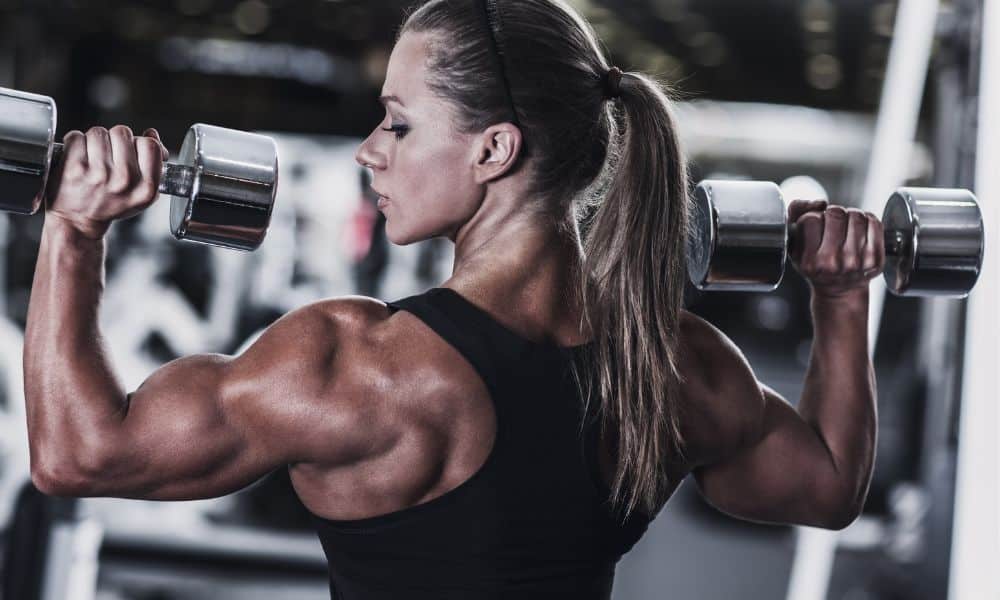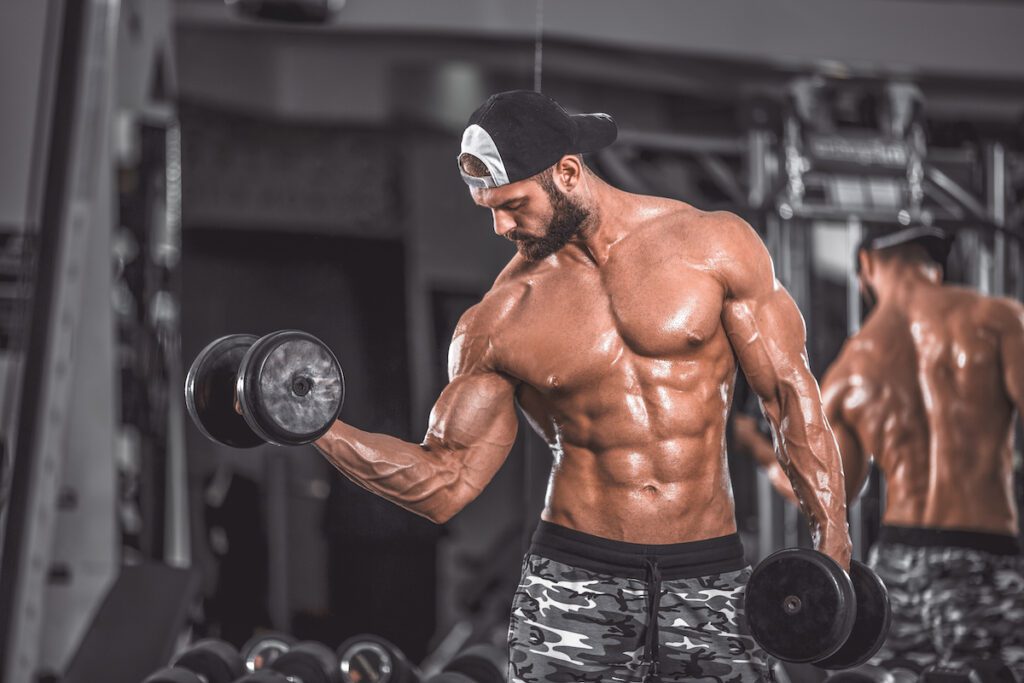When people think of resistance bands, they usually think of rehab and a little light aerobics for older people. Nothing could be further from the truth. Resistance band bodybuilding is an excellent way to build muscle, especially if you can’t get to the gym.
Studies show that resistance band bodybuilding is equally effective as free weights, even in the more prominent compound movements such as the squat. So if you’re looking to build muscle with resistance bands, you’ve come to the right place.
Research also shows that virtually all the benefits of resistance training are likely to be achieved in two weekly 15- to 20-min training sessions. In the early 1900s, Eugene Sandow, the founding father of bodybuilding, sold a home device that used rubber resistance bands for strength training. Let’s look at how influential resistance bands can be in building muscle.
The Benefits of Resistance Band Bodybuilding
Studies suggest that there isn’t much difference between training with resistance bands and free weights. The body can’t tell the difference between the two!
Both provide resistance, which you can progressively increase, and both allow a free range of movement. So there is little difference in how you can pack on muscle and burn fat between free weights and resistance bands.
The Muscle-Mind Connection
Every serious bodybuilder knows about the importance of the muscle-mind connection. The key to growing muscles is to create a direct link between your mind and the muscle you’re working on.
You might already know how hard it can target a specific muscle if you’re a beginner. However, you can’t just work on the pecs when your bench pressing. Well, resistance bands might be the secret weapon. With resistance bands for bodybuilding, you’re not focussing on the heaviness of the weight or the nearness of failure.
Also, this makes it much easier to focus on the muscles you’re working on. As the resistance increases towards the end of each rep, it forces you to squeeze that little extra. Thus, this is a great way to build a muscle-mind connection. You can even use resistance bands as a warm-up for free-weight exercises to help better target the muscles.
Constant Tension
Time under tension is one of the fundamental formulas for building muscle. The longer you can keep a muscle under pressure, the more it has to work.
In most free-weight exercises, we lose tension at the top of the movement because we lockout. The bench press and dumbbell bicep curl are just two examples. Instead, using resistance bands keeps tension on the muscle throughout the exercise.
Appearance
A resistance band might look like brightly colored, thin plastic tubing. Unfortunately, it’s barely as pleasing to the ego as benching free weights. However, resistance bands can apply up to 150 pounds of resistance.
Now, imagine doing 50 push-ups with 150 pounds on your back. Again, resistance bands are just as capable of stimulating muscle growth as free weights.
Planes of Movement
When you use free weights, your struggle is against gravity. Also, this limits the planes of movement. Thus, this can make them counterintuitive for those looking to train functional movement patterns.
Resistance bands open up the world of training on the horizontal plane, which is excellent news for athletes. If you’re a baseball player or golfer, resistance bands can help you replicate the movements you need in your sport. For example, one study found that resistance bands help strengthen the rotator cuff in baseball pitchers more than free weights.
No More Cheating
As you progress in bodybuilding with free weights and things get heavy, it’s easy to cheat. Instead, people use momentum to help get the weights up. Also, this might be a great way to squeeze out a few extra reps, but you’re no longer relying on the muscle’s strength.
When you use resistance bands, it is impossible to cheat the movement. When using resistance bands, it’s down to the targeted muscles alone.
Sheer Convenience
One of the most significant advantages of resistant bands is that they’re light and can be used anywhere. You can attach them to door handles, under chair legs, and even wrap them around yourself. As a result, resistance bands allow you to get a full-body workout without additional equipment or gym.
How to Use Resistance Bands for Bodybuilding
By now, you’re undoubtedly sold on the idea that resistance bands can help you build muscle too. So let’s look at specific exercises that will allow you to target each major muscle.
Resistance Band Back Exercises
Working the back couldn’t be any easier than with resistance bands. You’ll often see resistance bands used for assisted pull-ups, but you can use them for other major back exercises.
Bent-Over Row
The bent-over row is the staple of back exercises. It will improve your posture, strengthen your core, and work the following muscles:
- Latissimus dorsi (lats)
- Trapezius
- Rhomboids
- Erector spinae
- And even your biceps
To perform the bent-over row with a resistance band, start by standing in the middle of the band. Then, have your feet hip-width apart and grab onto each end of the loop. Next, keeping a neutral spine, bend at the waist. Ensure that your head, neck, and upper spine are entirely straight. Then arch your lower back.
Keeping your elbows tucked in, pull the band towards your torso. Squeeze your shoulder blades together at the top of the movement. To work your upper back, pull the band up towards your chest. To work your mid-lower back, pull the band up to your midsection.
Face Pull
Fitness enthusiasts crowned the face pull as the king of posture exercises. It mainly targets the rear deltoids, rhomboids, and middle trapezius. First, you’ll need to secure the band to something at waist height. Then, stand facing the band and hold it out in front of you.
Pull the band up towards your face by keeping your back straight and lifting your elbows. Squeeze your shoulder blades together and hold them in this last position. To increase the resistance, start by standing further away.
Lat Pulldown
Every bodybuilder wants wide lats, and the lat pulldown is a great first choice of exercise. Next, you’ll need to attach your resistance band to something above you. If that’s not possible, then you can kneel.
Hold the band out in front of you. Then, pull the band down to your waist without bending your arms. Hold that position once you feel the contraction in your lats, then raise your arms to the starting position.
Pull-Apart
The ‘pull apart’ mimics the rear-delt fly and is a great way to build your upper back. Again, you don’t need to secure the band to anything with this one.
Grab the band at each end and hold it in front of you. Keeping your arms straight, pull the resistance band apart as far as possible. Squeeze your shoulder blades together and hold this position before returning your arms in front of you.
Resistance Band Chest Exercises
When most bodybuilders think of building a bigger chest, they think of heavy barbell bench pressing. Resistance bands for bodybuilding can easily apply the resistance you need to make a bigger chest. You need to know how to use them.
Push-Ups
One of the most effective chest exercises is push-ups. You can easily take it up a notch with a resistance band. Put the resistance band around your upper back. Put your hand in each loop so that the band sits across the palm of your hand. Now perform push-ups like you usually would.
The great thing about using resistance bands for push-ups is that the resistance increases at the movement’s top. Thus, you’ll get a better contraction than the bench press or regular push-ups.
Fly
You’ll probably need two bands to do this, but it’s a significant variation of the dumbbell fly. Attach two bands behind you at chest level. Grab the end of each band and move forward, so you take the tension. Keeping your arms locked with a slight at the elbow, bring your arms in front of you.
Hold once you feel the contraction as you squeeze your arms in front of you and return. You should feel a stretch across your chest before you repeat the movement. If you don’t have two matching resistance bands or nowhere to fix two bands at the same height, don’t panic. You can take the resistance band across your back like with the push-up. Keeping the band in place can be tricky, but you should still perform the fly movement.
Resistance Band Shoulder Exercises
Shoulder exercises are accessible with a resistance band. You won’t need to attach your band to anything to grow monster shoulders.
Overhead Press
Start by standing inside the loop of your resistance band with your feet shoulder-width apart. Next, the hold band at shoulder-width apart. Bring the band up to level with your upper chest, and keep your elbows tucked in. Then drive upwards so that your arms lock out above your head. Finally, return the band to your upper chest and repeat.
Frontal Raise
Stand inside the loop of your resistance band with feet at hip-width apart. Hold the other end of the resistance band shoulder-width apart with an overhand grip. Keep your arms straight while raising your arms to be at shoulder level. Hold the position here, and then return your arms by your side. You can try standing with a wider stance if you need more resistance.
Lateral Raise
You’ll probably need to use a lighter band than you did for the frontal raise because you’re only working one shoulder at a time. For example, to work the right shoulder, stand on the resistance band of your left foot. Then, hold the other end of the band in your right hand.
Using a controlled motion, bring your arm up to your side until it reaches shoulder height. Hold here, and then return the band to your side. Next, stand on the band with your right foot to perform the lateral raise for your left shoulder. Finally, hold the band in your left hand.
Resistance Band Leg Exercises
Working the upper body with resistance bands is pretty straightforward. Unfortunately, most people doubt resistance band bodybuilding when they think about leg training. But you can use resistance bands for squats and deadlifts!
Squat
Stand inside the resistance band in your usual squat stance to perform a squat with a resistance band.
Hold the other end of the band at chest level with your palms facing upward. Keep your upper spine neutral and your lower spine slightly arched. Squat down so that your hamstrings are parallel to the floor. Then drive upwards through your heels until you’re standing upright.
Deadlift
The deadlift is commonly known as the king of compound exercises. This is because it’s great for targeting the glutes and hamstrings.
Loosen each band’s end around your feet to perform a deadlift with a resistance band. Then, assume a wide stance like you would in a sumo deadlift. Squat down and grab the middle of the band. Stick your bum out behind you and keep a slight arch in your lower back. Then, driving forward with your hips, pull the band until you’re standing fully upright. It’s important to keep looking straight ahead and not allow your back to bend when performing this exercise.
The Last Word on Resistance Band Exercises and Bodybuilding
Are you looking to build muscle without expensive gym memberships? Don’t you have room for a house full of gym equipment? Well, then resistance band bodybuilding is for you.
By using these exercises, you can easily create your full-body workout. It will be just as beneficial as hitting the free weights in the gym. If you’re looking to incorporate resistance band training with other training and great nutrition, then TF Clark fitness magazines have plenty more articles for you. Please share this article on Facebook or Twitter so others can learn more about professional bodybuilding and resistance bands.




